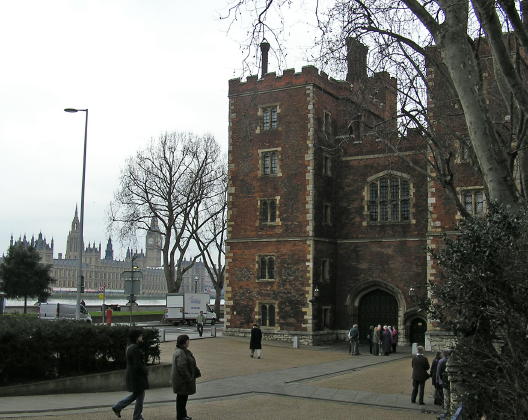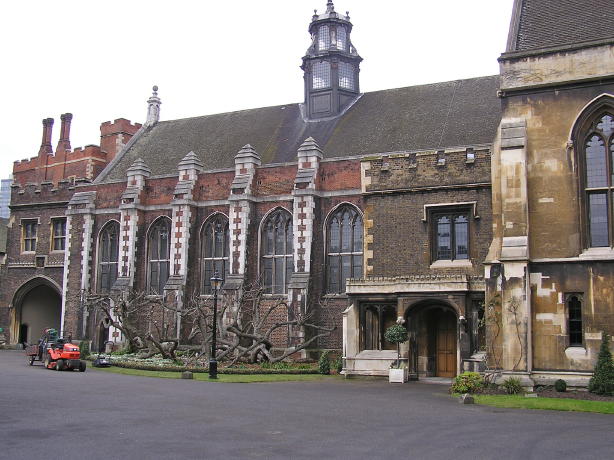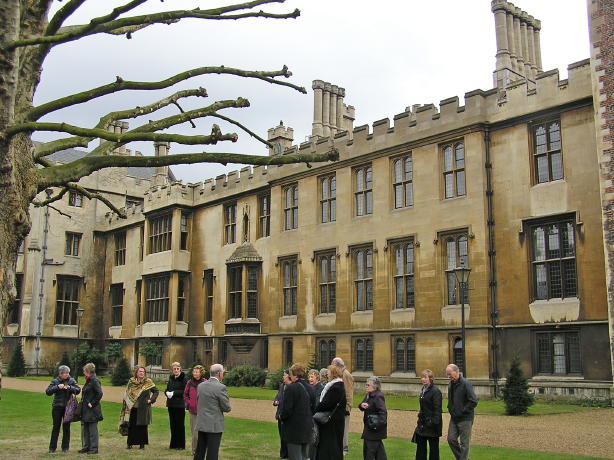
Visit Reports
Lambeth Palace March 12th 2010
The Lambeth Palace visit had been a “sell out” for weeks, so a full coach arrived at the early Tudor Morton’s Tower entrance, at about 15 minutes before our tour time. After knocking three times on the heavy wooden door, the gateman refused us entry until the guides arrived to escort us and firmly closed the door. It was our “Black Rod” moment! However, within ten minutes we were allowed inside and a fascinating tour began.
We were split into two groups, one opening and one concluding with a video introduction by the Archbishop of Canterbury. Lambeth Palace has been the home of the Archbishops of Canterbury since 1197 and our group’s tour started in the oldest surviving part: the13th century Crypt Chapel. It was originally a storage area, frequently flooded by the Thames, which then flowed just outside the Palace walls. It was there, we were told, that Archbishop Cranmer had begged Anne Boleyn to admit to the accusations against her, to gain the benefit of being beheaded rather than burnt at the stake. There was also a very plain table that serves as altar for daily worship, where, movingly, a candle had been lit and prayers said for Terry Waite every day of his captivity.

From the Crypt we went into the courtyard to view the front of the main building containing the public offices and private apartments, reconstructed by Edward Blore in late Gothic style from1829 to 1833.
There have been two disastrous periods for Lambeth Palace: firstly during Cromwell’s Commonwealth and secondly during the bombing in the Second World War. The Great Hall had been demolished by the Puritans and rebuilt in medieval style, with a beautiful hammer-beam roof in the1660’s and is now home to the famed Lambeth Palace Library. It was bitterly cold inside to preserve the books but we did wonder how the researchers coped!
For me, the most stunning room was The Guard Room, dating from the14th century, with its medieval roof and magnificent portraits of past Archbishops. I liked the three enormous, modern cartwheel shaped chandeliers which were a gift from American Anglicans. This room had once been the Great Chamber but now hosts banquets and large receptions.
There were other portraits of post-war Archbishops, including Ramsey, Carey and our own Robert Runcie, along the corridor to the State Dining Room and Drawing Room. These were relatively small, relaxing rooms with beautiful views over the gardens, for entertaining guests, with family photographs as well as fine paintings.

Towards the end of the tour we sat in the Chapel built originally in the first decades of the 13 th century. The windows had all been destroyed, first by the Puritans and then again by a direct hit from an incendiary bomb in WW11.The modern windows are very beautiful, some with vibrant blue Canterbury bell borders. In a small room overlooking the vestry, Cranmer had his study and is thought to have compiled his First Book of Common Prayer there.
When our group reached the lower floor of Cranmer’s Tower, we watched the video, bought a few postcards and, in my case a jar of honey from the Lambeth Palace bee hives. Finally there was a short tour of the gardens, believed to be the second or third largest private garden in London, after Buckingham Palace and, possibly, the American Ambassador’s garden in Regents Park.
It had been a privilege to tour the Palace with friendly and knowledgeable guides. Because, taking groups round is not a daily event for the Palace, there was a feeling of informality which made me feel more like a guest than a tourist-------apart from the gateman that is!
After the tour we went our various ways for lunch and the afternoon, with many visiting the Imperial War Museum’s galleries, where they also offer an excellent war themed menu, cooked on the premises. Others found the Garden Museum useful or walked along the Embankment to the Festival Hall or further. We were fortunate that whenever there was a shower, we were inside.
Carole Sugden March 2010
